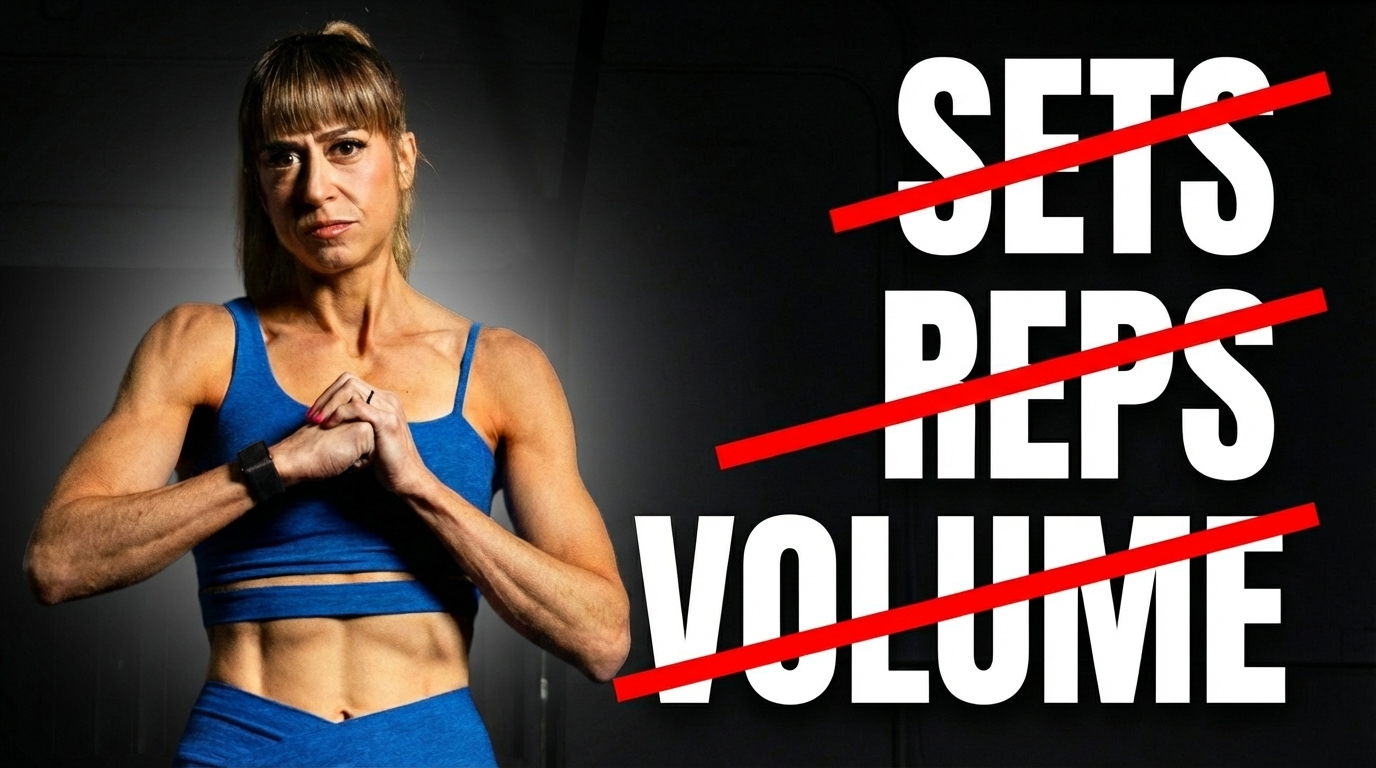So you want to achieve your first pull up and quickly build up to even double digits….
Then pull up practice is a must!
The only problem is, you can’t just keep practicing the same assisted pull up variation if you want to progress.
Ever even notice how, when you work on pull ups doing an assisted variation, you feel like you’re just getting stronger at that variation but never really moving forward?
Like maybe you can do another rep or it feels easier, but when you go to try a full pull up you still barely budge?
This is because doing assisted pull ups is necessary but only focusing on improving our pull ups by doing more assisted pull ups is also what keeps us stuck.
That’s why I want to share 7 “secrets” so you can improve those pull ups faster and not only build up to that first full one but be busting out 10 reps before you know it!
And the first two secrets I’ll share work together and have to do with how you progress your pull up practice.

#1: Don’t keep just adding reps. And #2: Use different types of modifications or assistance.
If you only ever practice pull ups with a specific amount of assistance or modification, you’re just going to get better at that assisted variation.
You’ll find that full pull up never gets any easier. You feel like you’re never getting any closer to your chin over that bar.
And this often happens because we just focus on doing another rep of the same modified pull up, which makes us stronger but only at that modified variation.
Instead of shooting for 5-10 reps of a modified pull up, shoot for 1-2 and keep focusing on advancing the version you’re using.
Do fewer reps and more rounds, using rest to your advantage to help you keep that same advanced variation as long as you can.
If you want to do 10 reps, use cluster sets of even just 1-2 reps with 15-20 seconds of rest in between to hit that total number.
Even error on way lower volume but pushing the variation of the pull up you use.
While you may think, what’s the point of 1 rep?!
That constant focus on doing ONE with a harder variation is truly what helps you progress.
And the more you see opportunity in even different modification techniques to help you progress, the more you can account for the weakness in each.
Bands give you the most assistance at the bottom when they are stretched.
This can be helpful if you can’t seem to pull up at the bottom BUT it also prevents you from learning that initial engagement of your back to pull up.
It’s why you may feel like if you could just jump to start, you’d be able to do just one.
Whereas the foot assisted pull ups, can be a great way to apply more even tension throughout, but also often lend us to struggle with clear progression and even use our legs unconsciously more as we fatigue.
But both of these can still leave you feeling like you can do another rep of the modified variation but can’t yet try that next step up.
This is where secret #3 comes in handy….
#3: Try eccentric only pull up variations to progress.
Whether you’re working on that first full pull up, or building up to 5, 10 or even 15 reps, focusing on eccentric only variations or even slow eccentric full reps will be key.
The eccentric portion of an exercise, is the elongation of the prime mover, and, in the case of the pull up, it is the lower down.
We are often strongest in the eccentric portion of the move, which means we can also often perform a harder variation of a movement if even for just this one portion of the exercise.
So if you’re struggling to break through to that next step in the pull up progression, lower assistance, trying to emphasize the eccentric is key.
You may even find this is how you first start performing the full pull up without any extra help – by only doing the lower down.
You will jump or use your feet or assistance to set up at the top of the pull up then slowly, taking at least a 3-5 count, lower down to full extension. Then repeat.
You’ll be surprised by how much stronger you feel and able to conquer a harder variation by just doing this lower down.
But by learning to control the move through even just a portion of the exercise and really create that mind-body connection as you build strength, you’ll be surprised by how much more quickly you see progression in your other modified pull up work.
And if you can’t yet take on your own bodyweight, you can still keep assistance to slow the lower down. You’ll just find you need less of it.
So include modified pull up work to start one workout a week with a second workout using the eccentric pull up variation as your skill work instead!
Again the more variations and modifications you can use, the more you can improve your pull ups from every angle.
Secret #4 Use holds at stick points will also help with this!
Isometrics, or holds, can be a great way to build strength, stability and control, especially at points we struggle with in exercises.
It can help us really focus on what we feel working and establish that mind-body connection which is so key to muscle activation and essential if we want to build up our pull ups.
We aren’t focused on trying to get through the movement. We are just focused on what we feel working and on engaging the correct muscles as we hold at the point we set to – we’re trying to create that shakeage!
Pull up holds can be used at any point we feel we fail or can’t get past.
Struggle with that initial engagement to pull up? Set right at that point with your back engaged at the bottom of the pull up and hold.
Struggle to get your chin just over that bar? Hold at the top.
Find you struggle midway up? Hold there.
And if you’re truly struggling with the full rep, complement your other two days of pull up work with the modified variation and eccentric pull ups with a day where you start your workouts with a few rounds of holds in each spot!
You may need assistance to hold, but focus on even shorter holds and a more advanced variation as you can.
But focus on those weak links in the movement to strengthen them.
Especially if you are using bands, holds toward the bottom to work on that initial scapular engagement or the movement of your shoulder blades down and together to unshrug your shoulders can be key!
The pull up holds are not only building strength and stability though. You also want to make sure you’re conscious when doing them of feeling your shoulder blades move and your BACK power the hold…
Not just your arms!
Because scapular control or our shoulder blade movement is really so often overlooked when we’re working on our pull ups.
That’s why secret number 5 is to…
Focus on scapular mobility and stability.
Ever end up just feeling your arms when doing pull ups or back work?
Elbows and neck constantly sore as you try to progress?
Often this is because we don’t have proper scapular control and aren’t effectively using our back to power the pull.
And this partly stems from the fact that most of us spend far too much time hunched over in our cars, at our desks or even just scrolling our phone on instagram.
This constant forward flexion or rounding forward often creates changes to how our body moves and leads to us not having proper scapular control.
We need to include moves in our warm up to work on opening up our chests while working to help us learn to control both the movement of our shoulder blades toward our spine but also down and together as if pulling them toward our butt.
Consider foam rolling moves for your chest and even levator scapula, muscles that can restrict this proper movement.
Consider stretches for your chest and even to work on thoracic extension or spinal extension.
Then do some activation work such as mini pull ups or band flies to focus on feeling the muscles that power those shoulder blades moving down and together.
This combination will help you get your back truly working to not only avoid elbow and neck pain but surprisingly improve the power you feel when you do pull ups.
This alone may skyrocket your strength as the right muscles are being used to the correct extents more efficiently!
And then once you have the correct muscles working, you need to strengthen them!
That’s why secrets number 6 and 7 involve strengthening two key muscle groups…
Secret #6 Include accessory moves to strengthen your back.
And secret number 7 Do hanging core work.
Build a stronger back and you’ll be able to pull more. So the stronger you get, the easier pull ups will become.
Focus on not only other vertical pulling exercises like lat pull downs but even horizontal pulls like bent over rows.
These moves help you truly work your back and focus on that scapular movement to engage the muscles correctly from every angle.
Even isolate that scapular movement and strength further with things like back flies that will also target your posterior delt to keep your shoulders healthy.
A bonus upper body move, often ignored but a game changer for your pull up progression, can also be the pull over.
This move not only works your lats, which are the key muscle powering your pull ups, but also works your pecs, serratus anterior and triceps…all of which have a bigger impact on our pull ups, or even chin ups, than we realize!
It truly isn’t just a back move!
That’s why you also can’t ignore core work when you want to improve your pull ups.
And I even love HANGING core work especially.
This will work not only your abs but your entire core and even help you learn to engage your back as you bring your knees to your elbows or toes to the bar, but also improve your grip strength which is key to adding pull up reps.
Now if you’re thinking, “I can’t do hanging abs!”
You can still modify them to the pelvic tilt hanging or even a foot assisted pelvic tilt or bicycle.
And if this is still too much, holding on to a bar, bench or edge of bench overhead as you pull down on it to tuck your knees or legs up can be a great starting point.
This still teaches you to engage your back as you work your core and even start to work on grip strength.
But that core work while also engaging your back is so key to also include in your workouts!
Using these 7 tips over the course of your week, with a set schedule you follow to track progress will help you see those pull up gains happen faster!
Just make sure to be intentional with the work you do in the gym and not just rush through moves!
Want amazing workouts to help you build that full body strength and mobility?
Check out my Dynamic Strength program!
–> LEARN MORE



0 Comments